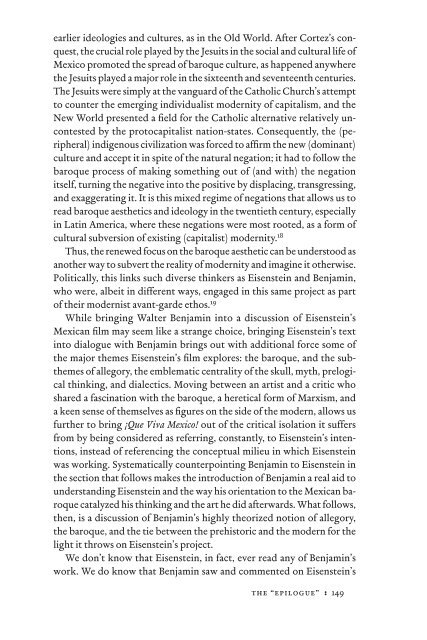In Excess: Sergei Eisentein's Mexico - Cineclub
In Excess: Sergei Eisentein's Mexico - Cineclub
In Excess: Sergei Eisentein's Mexico - Cineclub
You also want an ePaper? Increase the reach of your titles
YUMPU automatically turns print PDFs into web optimized ePapers that Google loves.
earlier ideologies and cultures, as in the Old World. After Cortez’s conquest,<br />
the crucial role played by the Jesuits in the social and cultural life of<br />
<strong>Mexico</strong> promoted the spread of baroque culture, as happened anywhere<br />
the Jesuits played a major role in the sixteenth and seventeenth centuries.<br />
The Jesuits were simply at the vanguard of the Catholic Church’s attempt<br />
to counter the emerging individualist modernity of capitalism, and the<br />
New World presented a fi eld for the Catholic alternative relatively uncontested<br />
by the protocapitalist nation-states. Consequently, the (peripheral)<br />
indigenous civilization was forced to affi rm the new (dominant)<br />
culture and accept it in spite of the natural negation; it had to follow the<br />
baroque process of making something out of (and with) the negation<br />
itself, turning the negative into the positive by displacing, transgressing,<br />
and exaggerating it. It is this mixed regime of negations that allows us to<br />
read baroque aesthetics and ideology in the twentieth century, especially<br />
in Latin America, where these negations were most rooted, as a form of<br />
cultural subversion of existing (capitalist) modernity. 18<br />
Thus, the renewed focus on the baroque aesthetic can be understood as<br />
another way to subvert the reality of modernity and imagine it otherwise.<br />
Politically, this links such diverse thinkers as Eisenstein and Benjamin,<br />
who were, albeit in different ways, engaged in this same project as part<br />
of their modernist avant-garde ethos. 19<br />
While bringing Walter Benjamin into a discussion of Eisenstein’s<br />
Mexican fi lm may seem like a strange choice, bringing Eisenstein’s text<br />
into dialogue with Benjamin brings out with additional force some of<br />
the major themes Eisenstein’s fi lm explores: the baroque, and the subthemes<br />
of allegory, the emblematic centrality of the skull, myth, prelogical<br />
thinking, and dialectics. Moving between an artist and a critic who<br />
shared a fascination with the baroque, a heretical form of Marxism, and<br />
a keen sense of themselves as fi gures on the side of the modern, allows us<br />
further to bring ¡Que Viva <strong>Mexico</strong>! out of the critical isolation it suffers<br />
from by being considered as referring, constantly, to Eisenstein’s intentions,<br />
instead of referencing the conceptual milieu in which Eisenstein<br />
was working. Systematically counterpointing Benjamin to Eisenstein in<br />
the section that follows makes the introduction of Benjamin a real aid to<br />
understanding Eisenstein and the way his orientation to the Mexican baroque<br />
catalyzed his thinking and the art he did afterwards. What follows,<br />
then, is a discussion of Benjamin’s highly theorized notion of allegory,<br />
the baroque, and the tie between the prehistoric and the modern for the<br />
light it throws on Eisenstein’s project.<br />
We don’t know that Eisenstein, in fact, ever read any of Benjamin’s<br />
work. We do know that Benjamin saw and commented on Eisenstein’s<br />
the “epilogue” : 149


